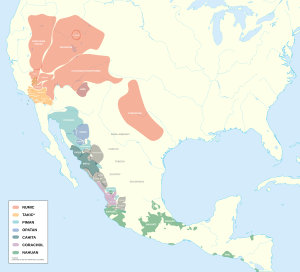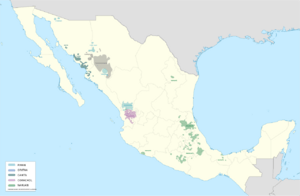Uto-Aztecan languages facts for kids
Quick facts for kids Uto-Aztecan |
|
|---|---|
| Geographic distribution: |
Western United States, Mexico, El Salvador |
| Linguistic classification: | One of the world's primary language families |
| Proto-language: | Proto-Uto-Aztecan |
| Subdivisions: |
Tübatulabal †
Serran †
Cupan
Tarahumaran
Cahitan
Opata †
Corachol
Piman
Nahuan
|
| ISO 639-5: | azc |
 Pre-contact distribution of Uto-Aztecan languages.
|
|
 Current extent of Uto-Aztecan languages in Mexico
|
|
The Uto-Aztecan language family is a group of more than 30 indigenous languages of the Americas. These languages are mostly spoken in the Western United States and Mexico. The name "Uto-Aztecan" comes from the Ute language spoken in Utah and the Nahuan languages (also called Aztecan) spoken in Mexico.
This language family is one of the biggest in the Americas. It has many speakers, many different languages, and covers a large area. The northernmost Uto-Aztecan language is Shoshoni, spoken as far north as Salmon, Idaho. The southernmost language is Pipil, found in El Salvador.
According to Ethnologue, there are 61 languages in this family. About 1.9 million people speak these languages. A large part of these speakers, almost 80%, speak a Nahuatl language.
Contents
What Are Uto-Aztecan Languages?
Uto-Aztecan languages are a group of related languages. They are like cousins in a big family. They all come from an older language called Proto-Uto-Aztecan. This family is one of the most important language groups in North America.
Where Did Uto-Aztecan Languages Start?
Experts believe the Uto-Aztecan languages began in the Southwestern United States. It is also possible they started in Northwestern Mexico. This area is considered their original homeland.
How Are Uto-Aztecan Languages Grouped?
The Uto-Aztecan family is often split into two main groups. One group is the Northern branch, which includes all the languages spoken in the United States. The other is the Southern branch, which includes languages spoken in Mexico.
Northern Uto-Aztecan Languages
The Northern group has several well-known branches. The Numic group includes languages like Comanche and Shoshoni. The Californian languages, once called the Takic group, include Cahuilla and Luiseño. Two other important languages that don't fit neatly into these groups are Hopi and Tübatulabal.
Southern Uto-Aztecan Languages
The Southern group of Uto-Aztecan languages is also divided into several branches. These include:
- The Tepiman languages, like O'odham and Tepehuán.
- The Tarahumaran languages, such as Raramuri and Guarijio.
- The Cahitan languages, which include Yaqui and Mayo.
- The Coracholan languages, like Cora and Huichol.
- The Nahuan languages, which are spoken by many people.
Images for kids
See also
 In Spanish: Lenguas uto-aztecas para niños
In Spanish: Lenguas uto-aztecas para niños


